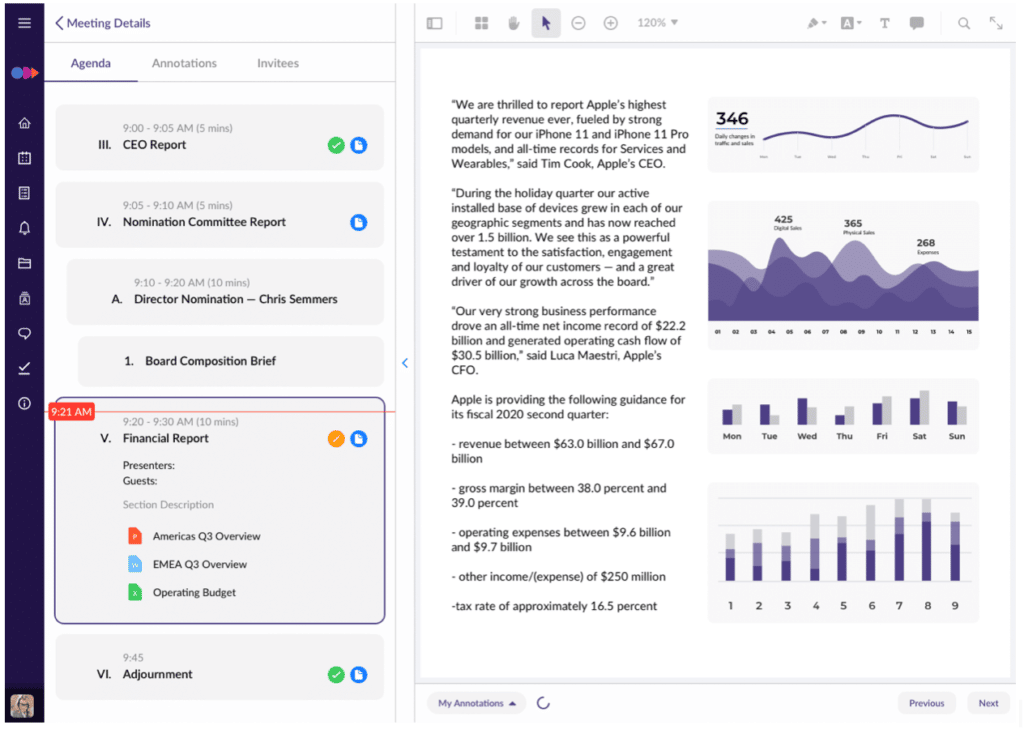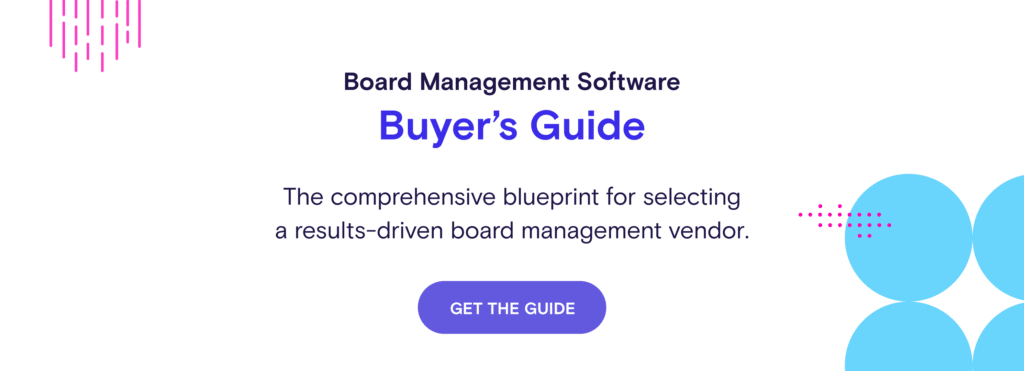
OnBoard Co-Founder and CEO Paroon Chadha discusses the 9 digital tools boards should use to achieve their best boardroom governance.
Despite a large-scale movement toward digital transformation, OnBoard Co-Founder and CEO Paroon Chadha says many businesses still rely on the equivalent of a digital MacGyver solution when it comes to boardroom work.
“You’re relying on Gmail, Dropbox. It doesn’t make any sense,” Chadha says, noting the lack of collaboration and security. “You’re not creating a stable environment like it deserves.”
It comes down to the difference between Board Management and Board Intelligence: Figurative duct tape may get the job done, but it’s certainly not helping boards be high-performing.
OnBoard offers board committees a platform tailored to create fluidity specifically within the boardroom, and from there on into the company. Here are the concrete ways that OnBoard secures and enhances routine board activities.
We sat down with Paroon in this, the second of a two-part series, to talk about how to create a well-functioning, inner-sanctum-worthy board. It comes down to a few things:
- Creating the perfect board meeting
- Investing in the right technology to optimize your systems
- The courage to change when needed
Miss the first blog? Read it here.
1. Prepare Collaborative Agendas
Board technology creates a designated and accessible shared place for agenda creation and collaboration. With a shared platform, the board chair or the chair of the Nom-gov committee can create agendas and share with the members in advance, with plenty of time to incorporate recommended changes.
“You are often agenda-collaborating with your board, so if there is a latent need for a certain topic to be more prominent in the agenda, it will come out,” Paroon says.
Agendas uploaded to the OnBoard platform highlight time allotted per topic, the person responsible for each item, and links to reference material. Does it streamline collaboration? The data says yes. Board members who use OnBoard software report they are receiving agendas an average of three days sooner than in the past.
2. Course-Correct in Real Time
Wondering if you’re on track mid-board meeting? Numbers don’t lie. Thanks to board tech, you can rely less on guesswork and more on hard facts.
OnBoard meetings come complete with an agenda-tracking feature that breaks down exactly how long specific participants talked. A red pace-line tells you where you are on the agenda.

You can also analyze the numbers after the fact. For instance, if one conversation monopolized 63% of the meeting, that’s helpful intel to take into account for future meetings in order to ensure more balance in the future.
3. Collect Meeting Ratings
In today’s world, you can rate everything from your Uber driver to your last employer on Glassdoor. Why shouldn’t board meetings get the same treatment?
It may seem unnerving to request such feedback, but it’s vital to understand board members’ perceptions of the meetings. For example, you may discover what members dislike in the current meeting structure. With this input, you can work together to make the system more efficient and enjoyable for all involved.
OnBoard automatically requests assessments from participants after each meeting to highlight areas for improvement. With real-time feedback, you can streamline processes that much faster. Paroon says 30% of OnBoard’s customers have used feedback to make improvements within the last 90 days thanks to the actionable insights.
4. Speed Up With Purpose-Built Systems
Board members are often extremely busy with plenty of other commitments. Part of the benefit of board tech is everything moves faster; agendas are delivered in a timely manner, board meetings are optimized and efficient, and communication between meetings such as follow-up notes are easy to access and manage in one spot.
Even meeting times are sped up with tech. For example, when COVID forced various boards to begin adopting and using technology like OnBoard, they reaped an unexpected benefit: Tech-enabled board meetings reduced the length of the average board meeting from 2.5 hours to 2 hours, or the equivalent of 20%.
5. Clean Records
Part of solid board governance is compliant and defensible record-keeping — especially if your company is seeking investment. Adarsh Mantravadi, General Counsel & Director, Business Development at OnBoard, wrote about how board communications may be subject to stockholder inspection rights in his piece, “The Layer of Protection Every Board Should Know About.”
“Boards need to be aware that their communications may be subject to stockholder inspection rights,” he writes. “Boards should take steps to ensure their minutes and other means of formal recordkeeping are robust enough to ward off any future argument that such records are incomplete, thus requiring the production of emails and/or text messages.”
With OnBoard, a record of board meeting minutes is gathered and approved within the platform, eliminating the need for last-minute scrambling. Governance platforms also ensure that mistakes like accidental forwarding of confidential information don’t happen. Using personal emails for board work can be a significant liability and embarrassment for unsuspecting board members.
The benefits of clear record-keeping aren’t just defensive. Operating in a savvy and scalable way creates confidence that your board will hear and act upon information, resulting in higher board member engagement — and demonstrates a level of professionalism that is evident to investors, too.
6. Expand Intentionally
Clear documentation of your meetings allows you to communicate knowledge easily across the entire organization. For example, OnBoard offers secure messaging, shareable annotations, and a feature for targeted announcements. Additionally, technology can help diversify your board as you grow.
“What is the board governance structure that is going to give you the right outcomes? OnBoard gives you tools to assess whether you have the right representation on your boards and committees,” Paroon says.
Among features like board assessments, meeting reviews, and board composition data, the puzzle pieces needed to make the right board refreshment decisions are at your fingertips.
7. Benchmark Reporting
Curious about what boards at similar companies are doing behind the scenes? Technology can help pull back the curtain by providing peer benchmarks on meeting cadence, board size, and committee structures.
OnBoard makes benchmark reporting available based on their experience with thousands of public, private and nonprofit organizations. If you’re interested to see whether you’re getting the most out of your board meetings, start by tapping into comparative insights.
“The goal isn’t to compare and despair,” Paroon says. “It’s to inspire boards and help companies get to the next level.”
8. A Safe Haven Is the Result of Preparation
One thing is sure in an uncertain world: You don’t want to wait for a crisis to be at your door to start getting the right board members and systems in place.
“The best day to fix the roof is on a bright sunny day. You can’t fix the roof when it’s already raining,” Paroon says.
Paroon saw it happen with the pandemic; suddenly, companies realized they needed to help their boards get organized in order to tackle the impending changes and challenges. Yet the companies that already had a strong, stable board in place were able to continue with less stress and scrambling.
In short, when the unexpected strikes, you won’t have the luxury of time. You’ll want to rely on a strong board and scalable governance you invested in during steady times.
9. Gain the Courage to Make Necessary Changes
Sometimes fixing the roof means making tough-yet-prudent decisions, like deciding whether to replace board members or overhaul your meeting structure. While such scenarios can be emotional, technology provides empirical data to guide you.
“There is a very big difference between facts versus feelings,” Paroon says. “Doing rigorous empirical analysis provides the basis — and the courage — for you to say, we’re going to take a clean sheet approach and assume everybody’s not going to be on the board for the next term. And we have to figure out who will actually end up on the board.”
Data provides reassurance that you’re acting on evidence rather than a gut feeling. It empowers you to make the difficult decisions that will create the board you need and deserve.
Defend the Inner Sanctum: Protect Your Board
While the ebbing pandemic has brought some reinvigoration to the business world, a falling stock market and rumbles of an impending recession are worrisome. Yet in the business world, turbulence is part of the game — and the best way to manage this is being prepared. This is why it’s imperative your board be the on-the-ready sanctuary at the eye of the proverbial storm.
This is Paroon’s goal with OnBoard: to help make every board high-performing. Make it a source of peace and productivity, akin to the feeling you get when stepping inside the inner sanctum of a church or castle — calm and secure, stable and enduring.
Where a board in turmoil will create negative reverberations throughout a business, a thoughtful and efficiently run board will work wonders. A well-run board establishes a grounded sense of confidence for leadership, which is felt throughout the company. It starts with creating a space for the board to thrive.
“The board chair has to create that space,” Paroon says. “And then they have to defend that space with all their heart. And we want to partner with boards in creating and bringing intelligent board experiences to every board.”
It takes a systematic investment in the right people and tools to create a board that serves as the beating heart of a healthy business. While nothing can prepare you for the exact challenges you’ll face as a business, governance technology helps equip your board to face them head on.
Explore firsthand how OnBoard’s board management software can take you there.
Want to fuel your startup for success? Get started with a free trial of OnBoard.
About The Author

- Adam Wire
- Adam Wire is a Content Marketing Manager at OnBoard who joined the company in 2021. A Ball State University graduate, Adam worked in various content marketing roles at Angi, USA Football, and Adult & Child Health following a 12-year career in newspapers. His favorite part of the job is problem-solving and helping teammates achieve their goals. He lives in Indianapolis with his wife and two dogs. He’s an avid sports fan and foodie who also enjoys lawn and yard work and running.
Latest entries
 Board Management SoftwareApril 12, 2024Board of Directors Compliance Training: 5 Best Programs
Board Management SoftwareApril 12, 2024Board of Directors Compliance Training: 5 Best Programs Board Management SoftwareApril 10, 20245 Best Compliance Training Programs
Board Management SoftwareApril 10, 20245 Best Compliance Training Programs Board Management SoftwareMarch 28, 20245 Advantages of an Initial Public Offering
Board Management SoftwareMarch 28, 20245 Advantages of an Initial Public Offering Board Management SoftwareMarch 26, 2024Initial Public Offering Examples: 3 Companies That Went Public
Board Management SoftwareMarch 26, 2024Initial Public Offering Examples: 3 Companies That Went Public



